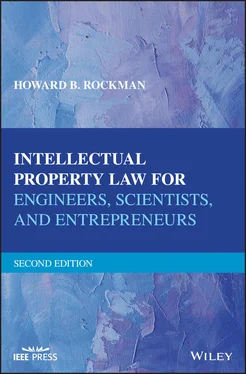The manual classifies all patents according to subject matter by classes and subclasses. There are well over 400 classes and 20 000 subclasses that cover practically every category of technology and type of invention known. The patent classification manual is basically an index to issued patents and published applications, and the searcher uses the manual to determine which classes and subclasses relate to your technology.
The patent classification system does more than divide patents into manageable related groups. The system divides the Patent Examiners into their own art groups, or areas of expertise. Thus, when directing a search, the attorney can particularly relate the scope of that search to the potential Patent Examiner’s specific area of knowledge. For example, when I was a member of the United States Patent Office examining corps in the early days of my career, I examined patent applications directed to automatic transmissions, automatic transmission fluid control systems, differential drive mechanisms for vehicles, and locking devices to override the differential action upon slippage of one of the wheels. By examining patent applications in these areas of technology on a daily basis, I gained a degree of expertise in each these particular technology areas. Thus, as new patent applications were filed that related to my area of technological expertise, it was easy for me to understand the technology, and the alleged advance in the technology. The work of the Patent Examiner will be covered in Chapter 11.
INVENTORS AND INVENTIONS
Thomas Alva Edison
THE LIGHT BULB

The icon of an American inventor is probably Thomas Alva Edison, who invented the phonograph, the first practical electric light bulb, an automatic timer for a telegraph, an electric voting machine, improvements in the telegraph and telephone, and electrical systems to power his light bulb. Besides being an inventor, Edison was also a shrewd businessman, and the methods he used to carry his inventions to the public, to his profit, involved many activities that might be deemed questionable given today’s business ethics and laws. This essay is limited to Edison’s life and his invention of the light bulb. The battle between DC and AC current involving Edison, Telsa, and Westinghouse will be discussed in the essay “Current Events” following Chapter 36.
Thomas A. Edison was born on February 11, 1847, in Milan, Ohio, the youngest child of Samuel and Nancy Edison. At the age of seven, Edison and his family moved to Port Huron, Michigan. Edison reportedly had hearing problems as a child, and although he had difficulty with his lessons in school, he became an avid reader, and by the age of 10 had established a laboratory in the basement of his house. Edison learned reading, writing, and arithmetic from his mother, who had taken him out of school because of his hearing problem. He spent most of his free time reading technical and scientific journals. When his mother got tired of the odors coming from the basement, Edison obtained a job as a train boy on the Grand Trunk Railway, and built a new laboratory in an empty freight car at the age of 12. Edison’s laboratory in the boxcar was shut down when it caused a fire on the train. While working for the railroad, he saved the life of a child of one of the station officials who had fallen on the tracks in front of an oncoming train. To reward Edison for saving his son, the father began teaching Edison how to use the train system’s telegraph.
From 1862 to 1868, Edison was employed as a telegrapher throughout the Midwest, New England, the South, and Canada. During this time, he invented a repeating telegraph, allowing automatic transmission of telegraphic messages. In 1869, his inventions, including the duplex telegraph, message printer, and an improved stock ticker, were doing so well that he began a career of full‐time inventing and business development. He became a highly visible inventor as a result of his inventions in telegraphy, which was the primary system used by business and finance concerns in those days to obtain the information necessary to control their businesses.
Edison moved to New York City in 1869. He sold his inventions for $40 000, allowing him to establish his first laboratory and manufacturing facility in Newark, New Jersey, in 1871. He also married Mary Stilwell and began his family. In 1876, Edison sold his Newark, New Jersey, facility and moved to Menlo Park, New Jersey, 25 miles away from New York City. Edison, along with two assistants, Charles Batchelor and John Kruesi, moved into the Menlo Park facility in March 1876. This laboratory employed highly skilled technicians, and became the prototype for later modern facilities devoted to only research and development, such as Bell Laboratories.
In 1877, urged by Western Union, Edison created a carbon‐button transmitter for use in telephone speakers and microphones that is still in use today. While experimenting with devices for recording telegraph signals, Edison developed the phonograph, which moved him to the top of the charts as an inventor in the late 19th century. However, it took 10 years for the phonograph to be available as a commercial product. Edison also invented the first talking moving pictures in 1913. He held 1,093 patents, leading all other American inventors in that category.
Edison was not the first to develop an electric light bulb. In the latter half of the 19th century, gas lights, oil lamps, and candles were used to light homes and offices. Electric arc lights, which used high‐voltage electricity to create a spark between two pieces of carbon, could only be used outdoors, such as in street lamps, lighthouses, and other public areas. The carbon arc created a blindingly bright light, which could not be “subdivided” to make small electric lights, which were unknown at the time. An arc light produced a light of approximately 4000 candle power, compared to the 10 or 20 candle power light produced by gas in the home. Arc lights were also operated by inefficient generators. When Edison began his experiments with light, it was known that an incandescent light could be made moderate enough for indoor use if the device could be constructed so that it would not extinguish itself rapidly. Prior to Edison’s work, all of the filament elements used in incandescent light experiments either burned up in the heat or melted. These experiments had preceded Edison by approximately 20 years, without any meaningful advances.
An English inventor, Sir Joseph Wilson Swan, is credited with inventing the first electric light bulb, which he demonstrated in 1878. However, the filament had a short life, and the bulb was not practical. The Swan invention, which used high current and low voltage, is still used in flashlights and in automobiles. One of the approaches used prior to Edison to obtain a practical electric light was to use filament materials composed of platinum that had a relatively high melting point and did not oxidize. The platinum material always reached its melting point despite efforts to prevent this from happening. A second pre‐Edison approach was to use a filament material such as carbon, whose melting point was so high that melting would not be a problem. However, the use of carbon in the lamp usually resulted in combustion of the carbon, despite the use of vacuum pumps to evacuate air from the bulb.
In mid‐1878, Edison was described as ill and very tired from the burdens of maintaining his position as the premier inventor in the United States. In the summer of 1878, he took a vacation to Wyoming with other scientists to view a solar eclipse. The other scientists on the trip discussed the fact that their compatriots were not able to come up with an electric light to replace the gas, oil, and carbon lights presently in use. Upon his return from vacation, Edison visited the workshop of William Wallace in Connecticut, where Mr. Wallace had on display an electric arc lighting system comprised of eight electric lights that were all lit at the same time by an electric generator, each arc light being equal to 4000 candles. Again, the subdivision of this light into smaller light units was then unknown. Edison realized that he had a window of opportunity to develop a subdivided electric light, since the demonstration by Mr. Wallace showed him that science had not yet reached the point of making a practical, subdivided electric light suitable for home use.
Читать дальше













